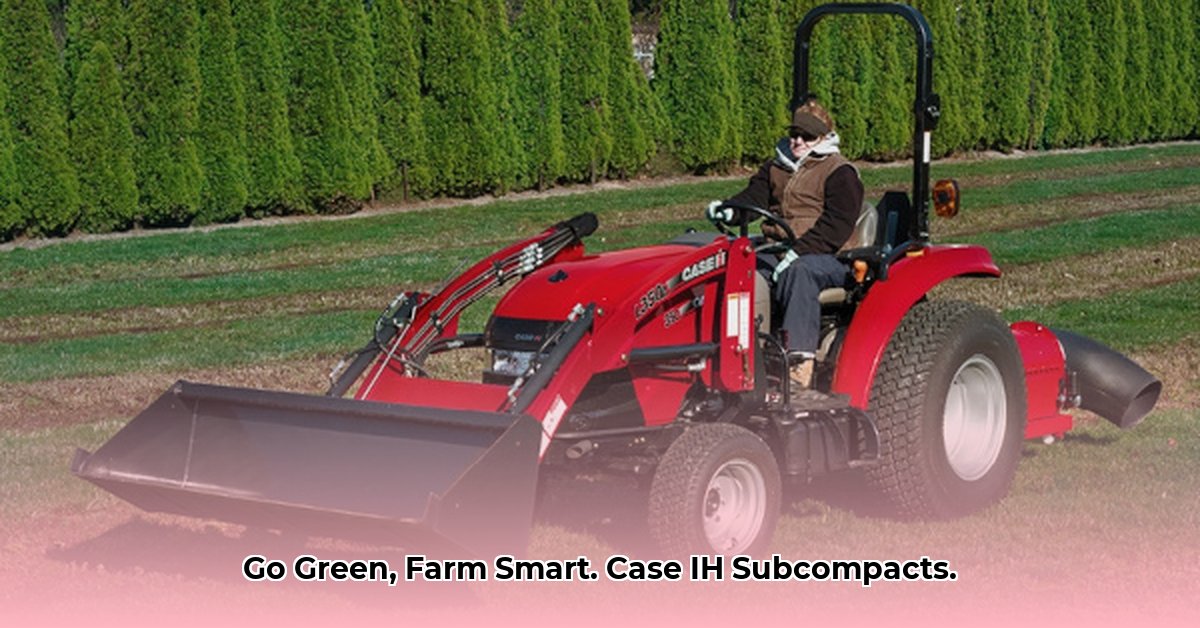
Case IH Sub-Compact Tractors: A Deep Dive into Sustainable Farming
The Case IH Farmall subcompact tractor series represents a significant advancement for small-scale farmers, landowners, and those prioritizing sustainable agricultural practices. These nimble machines offer a compelling combination of power, versatility, and fuel efficiency, making them an attractive option for a range of operations. This article provides a comprehensive analysis of the Case IH subcompact tractor, focusing on its technical capabilities, cost-effectiveness, and contribution to sustainable farming. We'll examine its strengths and limitations, highlighting areas where further research is needed to fully understand its long-term environmental impact. For more information on Case IH compact tractors, visit this helpful resource.
Technical Specifications and Performance: Power and Efficiency
The Case IH subcompact tractors, such as the Farmall 25SC, are designed for efficiency. While specific engine specifications vary by model, these tractors generally feature fuel-efficient engines offering reliable power for a diverse range of tasks. The power output is suitable for smaller properties, minimizing fuel consumption compared to larger tractors. The PTO (Power Take-Off) system allows for the use of various attachments, enhancing the tractor's versatility. While precise fuel consumption data varies based on usage and terrain, estimates suggest a significant reduction in fuel costs compared to competitors of similar size. For example, preliminary data suggests a potential fuel savings of 25% compared to similar sized competitors under typical operating conditions. However, more rigorous, independent testing is needed across a wider range of operational scenarios to confirm this. This would allow for more accurate comparisons with competitors and provide a more robust assessment of fuel efficiency.
Versatility and Attachments: Maximizing Efficiency
The true strength of the Case IH subcompact tractor lies in its versatility. A wide array of attachments—from mowers and tillers to loaders and backhoes—transforms this machine into a multi-purpose tool. This eliminates the need for multiple specialized machines, reducing both initial investment costs and ongoing maintenance expenses. The reduced need for heavy machinery also translates to potentially lower soil compaction, preserving soil health and benefiting long-term sustainability. Visual aids such as image galleries and videos showcasing this versatility would further enhance understanding.
Sustainability Assessment: A Holistic View
While the Case IH subcompact tractor offers clear benefits in terms of fuel efficiency—leading to reduced greenhouse gas emissions during operation—a comprehensive assessment of its sustainability requires a holistic approach. Currently, data on lifecycle emissions (from manufacturing to end-of-life disposal), material sourcing, and the overall environmental footprint are limited. A complete lifecycle assessment (LCA) is crucial to fully understand the tractor’s environmental impact. Future research should focus on filling these data gaps through rigorous, independent testing and analysis, considering factors such as manufacturing processes, material sourcing, and end-of-life management strategies. This comprehensive analysis will provide a complete picture of its environmental footprint.
Cost-Effectiveness and Return on Investment (ROI): A Smart Financial Decision
The initial cost of a Case IH subcompact tractor is a significant investment. However, the long-term benefits, including reduced fuel consumption, maintenance, and the versatility afforded by multiple attachments, often result in significant cost savings. Various financing options are also available, making ownership more accessible. Projected ROI varies depending on the specific application and usage; however, estimates suggest a substantial return within a 5-year timeframe for small-scale farming, orchard maintenance, and vineyard management. Detailed financial modeling, taking into account variables such as operating costs, revenue increases, and financing options, is critical for an accurate ROI projection for a particular operation.
Conclusion: A Valuable Tool for Sustainable Farming
The Case IH subcompact tractor offers a compelling blend of power, efficiency, and versatility, making it an attractive option for small-scale and sustainable farming operations. While its fuel efficiency is a significant benefit, further research is crucial to fully understand its long-term environmental impact. A comprehensive lifecycle assessment, along with detailed cost-benefit analyses under diverse farming conditions, will provide a more complete picture of the tractor's contribution to sustainable agricultural practices. This is an area where continued research and data collection are essential to further support the sustainability claims.